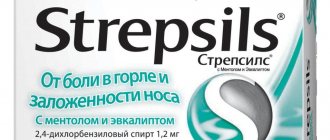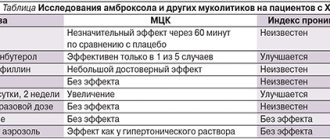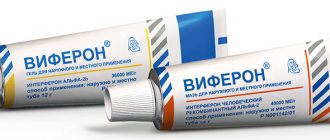November 15, 2021
43 132
20 minutes
Author, editor and medical expert – Klimovich Elina Valerievna.
Acute infections of the upper respiratory tract include inflammation of the nasal cavity, nasopharynx, pharynx and larynx (above the vocal cords) caused by various microorganisms. They all have similar symptoms (despite the variety of pathogens), so in everyday life they are often called “colds,” and doctors use the general term “acute respiratory diseases,” or acute respiratory infections, to refer to them.
Acute respiratory infections are observed all year round. On average, adults get colds 2 to 4 times a year, children get sick more often, 6-9 times - this is normal and necessary for the formation of a healthy immune system2. The peak incidence of acute respiratory tract infections occurs in the autumn-winter-spring period1. The likelihood of colds increases with the first cold snap, in September-October1, when we begin to go out less often and have longer contact with other people, among whom there may be carriers of pathogenic microbes or patients with acute respiratory infections. High humidity and cold outside often cause hypothermia and decreased immunity. Low air humidity in heated rooms leads to drying out of the nasal mucosa, increasing its permeability and susceptibility to infectious agents. Only in May, when the weather improves, does the incidence decline1.
Up to contents
Causes of upper respiratory tract diseases
Despite the similarity of manifestations, acute respiratory infections differ in the nature of their origin. They can be caused by different pathogens.
1.Viruses
They are the culprits of the “cold” in the vast majority of cases3 and then it is called ARVI (acute respiratory viral infection). About 40% of all such infections are associated with rhinoviruses1, which mainly affect the mucous membrane of the nose, nasopharynx and pharynx. They are followed by human coronaviruses, which cause nasopharyngitis, and parainfluenza viruses, which are responsible, among other things, for the development of laryngitis - inflammation of the larynx1. Adenoviruses and respiratory syncytial viruses are less common, as are other almost 200 types of viruses that cause respiratory tract infections4.
In approximately 1-2% of cases, viruses “can contribute to the activation of bacterial microflora”: they penetrate into the cells of the mucosa, cause their death, disrupt the functioning of the ciliated epithelium and the mechanisms of cleansing the respiratory tract, reduce local immunity and thereby create favorable conditions for the development of bacteria. In this case, the inflammation becomes viral-bacterial4.
2.Bacteria
Sometimes acute respiratory infections are initially bacterial in nature. Infectious agents are usually streptococci, pneumococci, Haemophilus influenzae, and Moraxella2. Bacterial infections of the upper respiratory tract often “cling” to young children with undeveloped immunity, elderly people whose bodies are weakened by health problems, and patients with primary and secondary immunodeficiency.
3. Atypical pathogens of acute respiratory infections
This group includes chlamydia, mycoplasma, pneumocystis, legionella and other microorganisms. The respiratory diseases they cause are rare, so we will not dwell on them.
Up to contents
Sinusitis
Sinusitis is a unilateral or bilateral inflammation of the maxillary sinus. The main cause of the disease is an infection that can enter the maxillary sinus from the nose, mouth, or through the blood and lymph. The predisposing factor is considered to be heredity and anatomical features of the structure of the facial skeleton.
During illness, the mucous membrane of the nose and maxillary sinuses swells, which makes nasal breathing difficult and contributes to the spread of infection. As a result, blood pressure and body temperature increase, headaches and general malaise occur. If sinusitis is not cured in time, a purulent process develops that can spread to the periosteum and bone tissue.
Conservative therapy is based on taking antibacterial drugs. If there is no effect, a puncture of the maxillary sinus is performed and the pus is evacuated, followed by therapeutic procedures. This manipulation is quite painful for humans. Osteopathy will help prevent the development of purulent changes and the need for invasive techniques.
An osteopathic doctor finds and eliminates the very cause of sinusitis, which often lies in the so-called blocks (violation of the natural mobility of anatomical structures). The specialist restores normal mobility of the bones of the base of the skull, facial skeleton and spine, thereby improving the outflow of mucus from the maxillary sinuses and blood supply to the mucous membrane.
How does infection and development of acute respiratory infections occur?
The source of infection is always people sick with ARVI, who pose the maximum danger to others on the 3-4th day of illness, when the release of viruses into the environment is especially intense5.
The main routes of transmission of respiratory tract infections are airborne droplets and contact4.
- Airborne
Viruses and pathogenic bacteria are contained in the saliva and sputum of the patient. When coughing and sneezing, droplets of nasal mucus and sputum quickly spread in the environment and, together with the air, enter the respiratory system of a healthy person. In confined spaces and public transport, the infection spreads especially quickly, so limiting visits to public places significantly reduces the likelihood of catching ARVI4.
- Contact
The mucus released when the patient sneezes and blows his nose ends up on his hands surrounding household items. Viruses settle on dishes, the patient’s desk, door handles, handrails of public transport, books, and furniture used by an infected person. From these objects, pathogenic microorganisms fall onto the hands of healthy people, and then when they touch the face they are carried into the nose and mouth. It has been proven that contact transmission of viruses is more important than airborne transmission5. Therefore, frequent hand washing can be called one of the main ways to prevent respiratory tract infections5.
How does the disease develop? Once on the mucous membrane of the nasal cavity, viruses invade its cells and begin to multiply intensively. Their number reaches a critical level within 1-3 days (incubation period), after which the first symptoms of the disease begin to appear. In this list:
- Rhinitis is inflammation of the mucous membrane of the nasal cavity.
- Pharyngitis is an inflammation of the pharynx, soft palate, uvula and lymphoid tissue of the pharynx.
- Epiglottitis is an inflammation of the upper part of the larynx and epiglottis, which closes the entrance to the trachea during swallowing.
- Laryngitis is inflammation of the larynx.
Most often, colds are associated with viral nasopharyngitis - a combined inflammation of the mucous membrane of the nasal cavity and pharynx. If the disease is mild and does not lead to complications, doctors usually write “ARVI” or “acute upper respiratory tract infection” in the patient’s card, without specifying the localization of the inflammatory process2,3.
Up to contents
Doctor, listen to me! or what do you hear there?
How often do patients complain after being examined by a doctor: “He didn’t even listen to me…”.
And it’s sad that you still need to look for a doctor who is ready to listen and has time for this during the appointment. But auscultation or listening to the chest organs (lungs and heart) does not take much time and is a mandatory manipulation for a general practitioner. Are you wondering what the doctor hears in his “ears,” called a stethoscope, and why does he need all this?
Breathing and wheezing
Everything that the doctor listens to above the surface of the lungs, he divides into the sounds of breathing and the sounds of wheezing. Breathing can be normal (vesicular) and pathological (hard, bronchial, weakened, etc.). Normally there should be no wheezing in the lungs.
Hard and not very
Let's start with breathing. Without it, it is quite difficult to switch to wheezing. Normally, no sub-sounds or special effects should be heard in the lungs. The so-called vesicular breathing is considered “healthy”. It is so called because it occurs as a result of vibrations of the walls of the pulmonary alveoli (vesicles) during inspiration. Naturally, not the entire volume of the lungs is filled at once, so we have a sound extended in time and increasing in intensity.
The old professors explained what vesicular breathing sounded like this: try saying the letter "f" as you inhale - you will get the sound of vesicular breathing. Another option is to drink tea from a saucer and sip.
Normally, in the presence of vesicular breathing, the entire inhalation and about a third of the exhalation should be audible. This is where the norm ends.
There are a lot of variations - weakening or strengthening of vesicular respiration, but this is already a propaedeutic jungle and we will not go there.
As soon as any troubles begin in the lungs or bronchi, this immediately affects the breathing pattern. For example, when bronchitis (inflammation of the mucous membrane + bronchospasm) makes it difficult for air to pass through the small bronchi, you can hear so-called hard breathing through a stethoscope, when both inhalation and exhalation are heard very well, completely.
There are many more different pathological breathings, but more about them next time. You just need to understand that there is ALWAYS some kind of main breathing, and various additional sound effects are layered on top of it, even if in intensity they cover the main breathing like the Krasnoyarsk Territory of Switzerland.
We wheeze little by little
Wheezing occurs against the background of a pathological process in the trachea, bronchi or lungs. They are divided into dry and wet, and this division is not arbitrary; the mechanisms of their occurrence differ significantly.
Let's start with dry wheezing.
The main condition for the occurrence of dry wheezing is that there must be a narrowing of the lumen of the bronchi. It is not so important what it will be - total, as in bronchial asthma, or focal, as in tuberculosis.
As a result, we get three mechanisms for the occurrence of dry wheezing:
- Bronchospasm
- Swelling of the bronchial mucosa during inflammation
- Accumulation of viscous sputum in the lumen of the bronchus
Then everything is simple: the larger the bronchus is involved, the lower the sound of wheezing will be. If the small bronchi have narrowed, we will hear wheezing; if the “strings” of viscous sputum are in the large-caliber bronchus, we will hear bass buzzing wheezing. Dry wheezing is usually very well audible not only to the patient himself, but also to the people around him, even without any stethoscopes.
From all that has been said, another conclusion follows: dry wheezing will be clearly audible both during inhalation and exhalation.
Let's move on to wet rales.
The main condition for the occurrence of moist rales is the presence of fluid in the lumen of the bronchi (sputum, blood, edematous fluid, etc.). When air passes through this secretion, many bubbles of varying diameters are formed. Overcoming the layer of liquid and entering the bronchus, the bubbles burst, making a characteristic sound. Take a thin straw and blow into the water through it - here is a model for the occurrence of moist rales.
Moist rales are better heard during inhalation, since during inhalation the speed of air movement through the bronchi will be greater.
Moist rales are divided by blistering. Depending on the caliber of the bronchi, you can hear small-bubble, medium-bubble and large-bubble moist rales. They arise, respectively, in the bronchioles and small bronchi, medium-caliber bronchi and main-caliber bronchi. The larger the blistering, the louder the wheezing. Large bubbles, for example, can be heard very well at a distance.
For example, with pneumonia, you can hear fine moist rales.
It is very difficult for a novice doctor to distinguish fine-bubbly moist rales from another sound effect - crepitus. Crepitation is not wheezing. It comes from the alveoli. When a certain amount of secretion accumulates in them, the alveoli stick together. And when you inhale, they fall apart. And this is the sound we hear.
Why is it important to find out whether it is crepitus or fine wheezing? Let me explain using the example of pneumonia: if we hear crepitus, this is bad, pneumonia is in full swing, and if fine wheezing is already good, the resolution phase has begun, or it is actually bronchitis, not pneumonia.
When you hear this damn crepitation ten times, you begin to wonder - how can it be confused with wheezing? Crepitation occurs only at the height of inspiration, it does not disappear after clearing the throat and the sound is very sharp. The same old professors advised rubbing the hair at the temple with your fingers - the resulting sound is very reminiscent of crepitus.
Here she is, my dear, against the background of bronchial breathing that I did not mention. But you will hear its peculiarity anyway.
But with bronchiectasis or if there is a cavity with fluid in the lung (abscess, cavity) that connects to the bronchus, you can hear medium- and large-bubble rales. Bubbles with such wheezing burst noticeably less often, but noticeably louder and more impressive.
Symptoms of acute respiratory infections
The clinical picture of all colds consists of the same general and local manifestations in varying degrees of severity and combinations.
General symptoms
Their severity depends on the type of pathogen and can vary from mild malaise to severe intoxication, accompanied by disruption of the functioning of internal organs and clouding of consciousness.
| Fever | It can be especially pronounced in young children, in whom the symptoms of intoxication prevail over the local manifestations of a cold5. Fever may be absent in mild cases of the disease, as well as in weakened patients and elderly people1. |
| Aches and pains in muscles and joints | In some patients, these sensations are limited to the appearance of a feeling of weakness; in others, the body aches are so strong that they do not allow them to sleep and force them to take painkillers. |
| Headache | It is more typical for influenza, but can also appear with other viral diseases, especially when they are severe1 and the temperature rises to 40 0C or higher. In these cases, the headache may be accompanied by nausea and unrelieved vomiting associated with irritation of the meninges1. |
| Gastrointestinal discomfort | Decreased appetite, nausea and vomiting, intestinal colic and diarrhea, as manifestations of a viral infection of the upper respiratory tract, are more common in children5. Sometimes they accompany streptococcal lesions5. |
Local manifestations of acute respiratory infections
Their diversity is determined by the level of damage to the respiratory tract.
| Runny nose | It begins with the appearance of itching, burning, nasal congestion, sneezing and copious mucous discharge from the nasal passages. As the process develops and bacterial microflora joins, the nasal mucus acquires a yellowish-greenish tint, there is less of it, and it begins to dry out, forming crusts in the nose. This reduces nasal congestion. |
| Sore and sore throat | They are associated with inflammation and dryness of the pharyngeal mucosa, intensify during swallowing and decrease slightly after warm drinking. The mucous membrane of the pharynx, palatine arches, uvula and tonsils look red and swollen. Enlarged lymphoid follicles are visible on the posterior wall of the pharynx. |
| Cough | One of the causes of cough during acute respiratory infection is the flow of mucus from the nose and nasopharynx into the respiratory tract. The second reason is associated with irritation of the receptors of the inflamed pharynx - in this case, the cough appears approximately on the 2-3rd day of the disease, more often it is dry, hacking, and even vomiting. A barking cough and hoarseness on the 4-5th day of illness indicate involvement of the larynx in the pathological process and the development of laryngitis. Children may develop false croup, in which attacks of convulsive coughing are accompanied by difficult, noisy breaths, and sometimes even periods of cessation of breathing5. The condition worsens at night, which is associated with an increase in mucus production and impaired sputum discharge at this time of day5. |
| Sputum | In the first days of the disease, the cough is always dry and painful. The appearance of sputum in the following days alleviates the suffering somewhat. When the upper parts of the respiratory tract are affected, it is not abundant. Its mucous nature indicates the viral nature of the disease; bacterial infections of the respiratory tract are accompanied by the release of purulent sputum. |
Additional symptoms
Along with the general manifestations typical of all diseases of the upper respiratory tract, in some cases specific symptoms are observed.
Thus, when infected with adenoviruses, signs of conjunctivitis appear; children often have abdominal pain associated with inflammation of the intra-abdominal lymph nodes5.
Respiratory syncytial virus tends to affect not only the upper, but also the lower parts of the respiratory tract, quickly causing the development of bronchitis and bronchiolitis1.
Bad breath is often a symptom of a bacterial respiratory tract infection. It is associated with the appearance of pus in the oropharynx - a product of inflammation and the activity of pathogenic microorganisms.
Up to contents
Diagnostics
Diagnosis of acute respiratory infections is based mainly on clinical symptoms of inflammation of various parts of the respiratory tract and the results of a medical examination. Given the predominantly mild course of the cold, no additional research is required. Virological diagnosis is usually not carried out, the nature of the pathogen remains unspecified - acute respiratory tract infections do not require specific treatment4,5.
Bacteriological analysis of throat swabs and rapid tests for group A beta-hemolytic streptococcus make it possible to differentiate common viral sore throats and pharyngitis from dangerous bacterial diseases that require immediate antibiotic therapy4,5. Bacteriological examination is also indicated in case of complications development and lack of effect from the antibiotics used4.
Up to contents
Diagnosis and treatment of respiratory diseases at the Clinical Hospital on Yauza
Doctors of the therapy department of the Yauza Clinical Hospital have all the capabilities for high-quality diagnosis and treatment of diseases of the bronchopulmonary system. The most commonly used methods for complex diagnostics are blood tests, x-rays and endoscopy. The Clinical Hospital on the Yauza has all these capabilities.
After a comprehensive examination, the therapist at the Yauza Clinical Hospital refers patients to a specialist who prescribes the optimal treatment.
Possible complications
Even though a cold is usually mild and goes away within 7-10 days, it can cause complications.
Complications associated with activation of bacterial microflora 1
| Acute purulent rhinosinusitis | or inflammation of the nose and paranasal sinuses. This is the most common complication of ARVI. You can suspect its development if the symptoms of a cold do not disappear after 7-10 days, nasal congestion persists, the temperature rises again, heaviness in the head in the sinus area and headache appear. |
| Acute otitis media | or inflammation of the middle ear. Its development is indicated by the appearance of shooting pain and a feeling of stuffiness in the ear. |
| Acute bronchitis | its bacterial form is accompanied by the release of purulent sputum and occurs more often in people with chronic problems of the respiratory system. |
| Pneumonia | one of the most dangerous complications of respiratory diseases. It’s worth thinking about if the fever lasts longer than 10 days, cough, general weakness and sweating persist. |
Bacterial complications of respiratory tract infections require treatment with antibiotics, so you should always consult a doctor if symptoms appear. In case of mild cases, colds in adults can be treated independently, without resorting to medical help. ARI in children, due to the high risk of complications, requires consultation with a pediatrician.
Up to contents
Tracheitis
Tracheitis is an inflammation of the trachea, mainly of an infectious nature. This respiratory disease is rarely isolated; it usually occurs together with rhinitis, laryngitis and pharyngitis. Inflammation of the trachea can have an acute or chronic course. In adults, inhalation of dirty air, toxic fumes and gases contributes to the development of tracheitis.
At the onset of the disease, the leading symptom is a dry cough, usually occurring in the morning and at night. A sore pain behind the sternum is also characteristic. After a few days, viscous, scanty sputum is released, which gradually becomes more abundant and acquires a mucopurulent character. If left untreated, inflammation spreads to the bronchi. A common complication of tracheitis is bronchitis and pneumonia.
To cure the pathology, pharmacotherapy, oil-alkaline inhalations, physiotherapy and climatotherapy are used. With the help of osteopathy, it is possible to reduce obsessive coughing and pain. After a course of osteopathic correction, the tracheal mucosa is restored faster, the functioning of the entire airway is normalized, and the general condition of the person improves.
Treatment of upper respiratory tract infections
All methods of treating colds can be divided into non-drug and medicinal.
Non-drug methods
Mode
In most cases, treatment of acute respiratory infections does not imply hospitalization, but compliance with the home regime is always mandatory. Moreover, it is better to spend the first days of the disease, while the fever persists, in bed. This is especially important for children, but adults should not ignore this rule either.
Hygiene measures
It is necessary to maintain a room temperature of about 200 C and a humidity of about 50-70%, which is achieved through wet cleaning and frequent ventilation of the room2. Heat and dry air “dry” the airways, intensify coughing and promote bacterial infection. Cold and excessive humidity in the room lead to hypothermia and aggravate the course of acute respiratory infections.
To purify the air from viruses and bacteria, it is recommended to use ionizers, bactericidal and ultraviolet lamps2. They help reduce the risk of bacterial complications during treatment and also protect family members and guests from respiratory tract infections.
Diet
The diet should be chemically and mechanically gentle, aimed at fully satisfying the body's needs for nutrients, vitamins and microelements. It is better to exclude spices, spices and smoked foods, limit salt and sugar intake, reduce the amount of sour and carbohydrate foods: sweets, flour products, potatoes, legumes and corn. You should not get carried away with raw vegetables and fruits; it is optimal to consume them boiled and baked. Meat – mostly minced and in small quantities. Fermented milk products, various fruit drinks, jelly, and puddings are useful.
Drinking regime
Compliance with the drinking regime is a fundamental principle in the treatment of diseases of the upper respiratory tract4. Fever is accompanied by increased sweating. To prevent dehydration and maintain optimal moisture in the mucous membranes, you need to consume a sufficient amount of fluid (at least 30 ml per 1 kg of body weight per day)4. You can drink plain clean water, still mineral water, fruit drinks, compotes without sugar, cold green or herbal tea. It is advisable to avoid coffee, cocoa, and carbonated sweet drinks: they irritate the mucous membranes.
Nasal rinsing and gargling
Liquid nasal mucus has a protective function. It prevents the penetration of microbes into the mucous membrane, moisturizes and cleanses it. Nasal rinsing is aimed at removing dried mucus and maintaining a liquid state of nasal secretions4. As rinsing solutions, you can use regular saline solution and special preparations based on sea water.
Gargling helps cleanse the mucous membrane of the oropharynx, eliminate soreness, burning and pain in the throat, and reduce cough4. For rinsing, decoctions and infusions of medicinal herbs that have an anti-inflammatory effect are suitable4.
Medication methods
Methods of drug therapy for ENT diseases, in particular respiratory tract infections, can be divided into general and local.
General treatment
It includes etiotropic therapy: antiviral and antibacterial, implying the destruction of pathogens, as well as symptomatic therapy aimed at combating the manifestations of the disease.
Antiviral and antibacterial therapy
Antiviral drugs for ARVI are less effective than for influenza1,5, so the advisability of their use is questionable.
Systemic antibiotics (taken orally, by injection and infusion) are indicated only in cases of proven bacterial infection, in particular with the development of bacterial complications such as acute tonsillitis, otitis media, sinusitis1,5.
Up to contents
Tuberculosis
Tuberculosis is one of the most unpredictable and severe lung diseases. Generalized forms are often fatal. The infection is especially dangerous for children and people with immunodeficiency. Diagnosing tuberculosis is often difficult. Treatment includes a combination of several drugs that suppress the growth and reproduction of mycobacterium tuberculosis (Koch bacillus). The minimum course of therapy is 6 months. Treatment often causes side effects and unwanted consequences. In recent years, forms of mycobacteria resistant to etiotropic pharmacotherapy have been increasingly registered. Then traditional medicine becomes powerless in the fight against the disease.
The use of alternative methods is often prohibited by doctors. In most cases, local and general massage for respiratory diseases is acceptable, but for tuberculosis, any massage procedures are performed only with the permission of a phthisiatrician. Osteopathy is also performed after medical consultation and during the inactive stage of the disease.
Symptomatic treatment
It is aimed at combating the symptoms of the disease - manifestations of respiratory tract infection, such as fever, nasal congestion, sore throat and cough.
- Antipyretic drugs
With uncomplicated acute respiratory infections in adults, the temperature rarely exceeds 380 C. According to WHO recommendations, treatment of fever with antipyretic drugs in adults should be started only if the fever has reached 38.50 C10. For diseases of the heart, lungs, nervous system and poor tolerance to high temperatures, you can take medications earlier.
Children with acute respiratory infections have a fever more often than adults, but you should not abuse antipyretic drugs.
Based on generally accepted rules, a child’s temperature should be brought down5,10 in the following cases:
- if it rose above 390 C;
- if the child is less than 3 months old and the temperature has reached 380C or higher;
- if a child does not tolerate heat well, he is predisposed to seizures, heart defects, arrhythmias and diseases of the nervous system.
Do not try to reduce the temperature to normal values; it is enough to reduce it by 10C5.10.
Important! In any case, if your child’s temperature rises, you should consult a doctor and strictly follow his recommendations.
- Vasoconstrictor nasal drops
Vasoconstrictors - decongestants - can be used to relieve nasal congestion to relieve nasal breathing and reduce the risk of developing sinusitis. However, it is better to limit their use in order to avoid the addictive effect and the development of drug-induced rhinitis4,5.
- Remedies for sore throat
There are special solutions for gargling, such as HEXORAL® SOLUTION5.
The main active ingredient of HEXORAL® SOLUTION is the antiseptic hexetidine, which has antiseptic and antifungal effects6. It is active against some influenza A viruses, respiratory syncytial virus and herpes simplex virus type 1, which affect the respiratory tract, gram-positive bacteria, which include beta-hemolytic streptococcus, and Candida fungi, which are activated by decreased immunity and the use of antibiotics6.
The analgesic effect of hexethidine helps to cope with sore throat and relieve sore throat. Due to its high safety profile, the drug can be used not only in adults, but also in children over 3 years of age.
HEXORAL® in AEROSOL form is especially convenient for children who do not know how to gargle. HEXORAL®AEROSOL for the whole family is equipped with several nozzles of different colors, which allows it to be used by several patients.
To soothe the throat during the day, adults and children over 4 years old can use HEXORAL® TABS, and adults and children over 6 years old can use TABS CLASSIC. Absorbable tablets HEXORAL® TABS contain not only a broad-spectrum antiseptic, but also an analgesic component that helps cope with sore throat7. Aromatic oils give the tablets a pleasant minty aroma.
HEXORAL® TABS CLASSIC tablets have an orange, lemon, honey-lemon or blackcurrant flavor, contain amylmetacresol and dichlorobenzyl alcohol7, which enhance the antiseptic effect of each other and are active against most gram-positive and gram-negative bacteria and fungi. Adults and children over 12 years of age may benefit from HEXORAL® TABS EXTRA based on the same antiseptic components with the addition of lidocaine, which has a powerful analgesic effect and helps fight even severe sore throat8.
- Cough suppressants
For acute respiratory infections and cough, often caused by irritation of the pharynx and nasal mucus flowing into it, nasal hygiene, gargling and the use of anti-sore throat remedies can help eliminate this unpleasant symptom5.
For coughs associated with inflammation of the upper respiratory tract, in particular laryngitis, adults and children over 12 years of age can use raspberry-flavored cough syrup HEXO BRONCHO® based on guaifenesin9. It increases the secretion of mucus, thins sputum and makes it easier to expel. All this helps soften the cough and speeds up the clearance of the airways9.
The information in this article is for reference only and does not replace professional advice from a doctor. To make a diagnosis and prescribe treatment, consult a qualified specialist.
Literature
- “Acute respiratory viral infections in adults” Clinical recommendations Reviewed and recommended for approval by the Specialized Commission of the Russian Ministry of Health in the specialty “infectious diseases” at a meeting on March 25, 2014 and October 8, 2014.
- V.M. Delyagin. Acute respiratory diseases in children. Consilium Medicum. Pediatrics. (App.) 2009; 01: p. 24-27.
- Ovchinnikov A.Yu., Miroshnichenko N.A.. Upper respiratory tract infections in children and adults: recommendations of an otorhinolaryngologist. RMJ "Medical Review" No. 26, 2021, p. 1739-1742.
- Svistushkin V.M., Mustafaev D.M. Acute respiratory viral infections: principles of rational therapy. Regular issues of "RMZh" No. 26, 2014, p. 1897.
- V. K. Tatochenko. ARVI and influenza in children. The main difficulties of diagnosis and the possibilities of rational therapy. “Attending Physician”, No. 9, 2015.
- Instructions for the preparations HEXORAL® SOLUTION.
- Instructions for the preparations HEXORAL® TABS and TABS CLASSIC.
- Instructions for the drug HEXORAL® TABS EXTRA.
- Instructions for the drug HEXO BRONCHO®.
Up to contents








